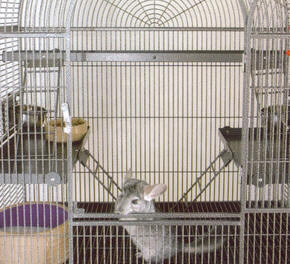A look at the features and characteristics of a good chinchilla cage.

Chinchillas are a small rodent native to South America, found in rocky, arid areas
in the mountains. They are perhaps best known for their incredibly soft, thick,
luxurious fur. In the wild this fur protects them from the elements, but in captivity
it makes them somewhat susceptible to overheating. This must be considered when
deciding where to place your chinchilla in the house. A cooler, quiet (but not drafty
area) is preferred.
The Cage
The larger the cage, the better. The minimum floor space is about 24 by 24 inches,
and a tall cage is best; if possible get a tall cage with shelves and ladders that
allow the chinchilla to climb. Wire is the best cage material, and avoid plastic
cages or accessories and chinchillas chew and destroy plastic readily.
For ease of cleaning, a pull out tray is a nice feature. The tray can be lined with
wood shavings (avoid cedar shavings, and hardwood shavings such as aspen are preferred
over pine), or newspapers. Many chinchilla cages have a wire floor, which is nice
for keeping them out of dirty cage bottoms but can be hard on chinchilla feet. If
you use a wire floor or have all wire shelves, provide at least one wooden platform
(or cover part of the wire with a piece of wood) to give the chinchilla's feet a
break. A nest box, made of wood, should also be provided.
Where to Put the Cage
The cage should be placed in a quiet area of the home where human activities won't
disturb (and stress) them during the day. As mentioned previously, the area should
also be cool, but not drafty, and not exposed to direct sunlight which could cause
overheating. Summertime temperatures must be monitored to make sure the ambient
temperature is not much over 77 F (25 C). If you do not have air conditioning, placing
a shallow pan of ice cubes in the cage may help. Place the cage on a table or stand
as this will help make the chinchilla feel secure (chinchillas can be intimidated
if you must lean over the cage to interact with them).
Water Bottles
Glass water bottles are ideal because the chinchilla can't chew through them. If
you use plastic, encasing it or creating a barrier to it with wire mesh should reduce
the risk of damage (you can also get commercial chew guards). For feeders, hopper
style feeders that attach to the outside of the cage are nice because they can't
be tipped and the chinchilla won't be able to urinate in their food. If a food bowl
is used it should be a heavy ceramic bowl to reduce tipping, and it must be cleaned
daily.
Toys
Toys can be provided too - blocks of wood and tree branches (free of pesticides)
are good chew toys. Some of the wooden parrot toys make good toys as well, as do
the willow balls and rings that you can find for rabbits. It is important to provide
toys that do not have small or plastic parts that could be ingested. In addition,
a "chinchilla block" or pumice block can be provided for chewing and this will aid
in keeping the teeth trim.
Wheels
Wheels can provide excellent exercise, although you may find that unless the chinchilla
is introduced to the idea at a fairly young age it may not take to running on a
wheel. A 12-15 inch wheel is preferable, ideally a solid surface metal wheel with
an open side (wire wheels are dangerous to feet and tails). It is also possible
to get translucent plastic balls in which the chinchilla can "roll" around the house
by running - keeping the chinchilla and the furnishings safe. Again, getting a chinchilla
used to this at an early age will make them most comfortable with this.
Playtime Outside the Cage
Many people also have their chinchillas out of the cage for a play and exercise
time each day. This requires close supervision and a little chinchilla-proofing
due their chewing tendencies. Electrical cords pose a grave danger and should be
shielded or kept out of reach. Once the chinchilla is tame it should be relatively
easy to tempt the chinchilla onto your hand with a favorite treat (e.g. a raisin)
and carry it back to the cage. However, most will return to their cages after period
of time as they look on it as their home. Chasing and catching the chinchilla should
be a last resort, as it is very stressful on the chinchilla (and owner). For more
information on advice on toys and safe playtime for chinchillas, see
Chinchilla Playtime.
Lianne McLeod
http://exoticpets.about.com
Related Articles:
 Caring for Orphaned Chinchillas
Caring for Orphaned Chinchillas
 Chinchilla Care
Chinchilla Care



 Chinchillas are a small rodent native to South America, found in rocky, arid areas
in the mountains. They are perhaps best known for their incredibly soft, thick,
luxurious fur. In the wild this fur protects them from the elements, but in captivity
it makes them somewhat susceptible to overheating. This must be considered when
deciding where to place your chinchilla in the house. A cooler, quiet (but not drafty
area) is preferred.
Chinchillas are a small rodent native to South America, found in rocky, arid areas
in the mountains. They are perhaps best known for their incredibly soft, thick,
luxurious fur. In the wild this fur protects them from the elements, but in captivity
it makes them somewhat susceptible to overheating. This must be considered when
deciding where to place your chinchilla in the house. A cooler, quiet (but not drafty
area) is preferred.